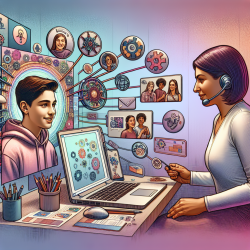Introduction: A New Era in Child Speech Therapy
In the rapidly evolving world of healthcare, the integration of deep learning models with electronic health records (EHRs) offers unprecedented opportunities for enhancing child speech therapy outcomes. This blog explores insights from the systematic review titled "Opportunities and challenges in developing deep learning models using electronic health records data" and discusses how practitioners can leverage these insights to improve their skills and outcomes for children.
Understanding the Potential of Deep Learning in EHRs
The systematic review highlights the transformative impact of deep learning on healthcare analytics. Deep learning models, particularly those using EHR data, have shown superior performance in tasks such as disease detection, clinical event prediction, and data augmentation. These models minimize the need for manual feature engineering, allowing for more accurate and efficient analysis of complex datasets.
Key Insights for Speech Therapy Practitioners
For speech therapy practitioners, the integration of deep learning with EHRs can significantly enhance the delivery of personalized therapy plans. Here are some actionable insights:
- Disease Detection and Classification: Utilize deep learning models to identify speech-related disorders early. By analyzing patterns in EHR data, practitioners can detect anomalies and intervene sooner, potentially improving long-term outcomes.
- Sequential Prediction of Clinical Events: Implement models that predict future speech therapy needs based on historical data. This allows for proactive adjustments in therapy plans, ensuring that interventions are timely and effective.
- Concept Embedding: Use deep learning to derive meaningful representations of speech therapy sessions. This can help in understanding complex speech patterns and tailoring interventions to individual needs.
- Data Augmentation: Generate synthetic EHR data to simulate various speech therapy scenarios. This can aid in training models to handle diverse cases, enhancing their robustness and applicability.
Challenges and Solutions
Despite the promising potential, several challenges remain in implementing deep learning models with EHRs:
- Data Quality and Availability: High-quality data is essential for effective model training. Practitioners should focus on improving data collection methods and ensuring comprehensive EHR documentation.
- Model Interpretability: Deep learning models are often viewed as "black boxes." Efforts should be made to enhance model transparency, allowing practitioners to understand and trust the recommendations provided by these models.
- Ease of Deployment: Integrating deep learning models into existing EHR systems can be complex. Practitioners should advocate for user-friendly interfaces and seamless integration solutions to facilitate adoption.
Encouraging Further Research
The review underscores the need for ongoing research to address these challenges and fully realize the potential of deep learning in EHRs. Practitioners are encouraged to engage in collaborative research efforts, contribute to the development of innovative solutions, and stay informed about the latest advancements in the field.
Conclusion: A Call to Action
By embracing deep learning and EHR integration, speech therapy practitioners can revolutionize the way they deliver care to children. These technologies offer the promise of more personalized, effective, and data-driven therapy plans that can significantly enhance child development outcomes.
To read the original research paper, please follow this link: Opportunities and challenges in developing deep learning models using electronic health records data: a systematic review.










